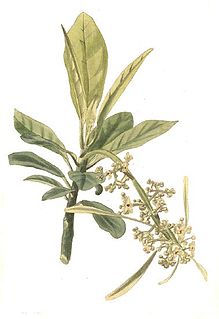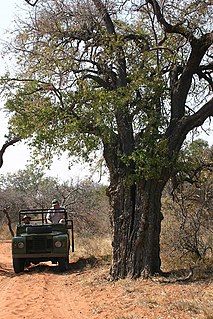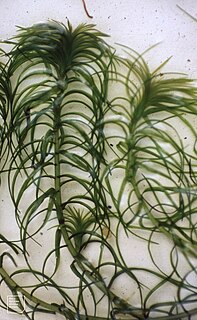
Olea is a genus of about 40 species in the family Oleaceae, native to warm temperate and tropical regions of the Middle East, southern Europe, Africa, southern Asia, and Australasia. They are evergreen trees and shrubs, with small, opposite, entire leaves. The fruit is a drupe. Leaves of Olea contain trichosclereids.
Wielandia is a genus of flowering plant, of the family Phyllanthaceae first described as a genus in 1858. The plants are native to Kenya, Madagascar, and to various other islands in the Indian Ocean.

Omphalea is a plant genus of the family Euphorbiaceae first described as a genus in 1759. It is native to tropical parts of the Americas, the West Indies, Asia, Australia, and Africa.
Epiprinus is a genus of plant of the family Euphorbiaceae first described as a genus in 1854. It is native to Indochina, Sumatra, southern China, and the Indian Subcontinent.
- Epiprinus balansae(Pax & K.Hoffm.) Gagnep. - Vietnam
- Epiprinus lanceifoliusCroizat - Vietnam
- Epiprinus malayanusGriff. - Myanmar, Thailand, Peninsular Malaysia, Sumatra
- Epiprinus mallotiformis(Müll.Arg.) Croizat - southern India
- Epiprinus poilaneiGagnep. - Vietnam
- Epiprinus siletianus(Baill.) Croizat - Hainan, Yunnan, Assam, Laos, Myanmar, Thailand, Vietnam
Pycnocoma is a genus of plant of the family Euphorbiaceae first described as a genus in 1849. It is native to tropical Africa and Madagascar.
Tannodia is a plant genus of the family Euphorbiaceae first described as a genus in 1861. It is native to Africa, Madagascar, and Comoros. It is dioecious.
- Tannodia congolensis - Zaïre
- Tannodia cordifolia - Comoros, Madagascar
- Tannodia grandiflora - Diana Region in Madagascar
- Tannodia nitida - Atsinanana in Madagascar
- Tannodia obovata - Atsinanana in Madagascar
- Tannodia pennivenia - Atsinanana in Madagascar
- Tannodia perrieri - Madagascar
- Tannodia swynnertonii - Tanzania, Mozambique, Zimbabwe
- Tannodia tenuifolia - Kenya, Tanzania, Malawi, Mozambique, Zimbabwe, Zambia

Spirostachys is a plant genus of the family Euphorbiaceae first described as a genus in 1850. It is native to Africa. Zuloaga, F. O., O. Morrone, M. J. Belgrano, C. Marticorena & E. Marchesi. (eds.) 2008. Catálogo de las plantas vasculares del Cono Sur. Monographs in systematic botany from the Missouri Botanical Garden 107(1–3): i–xcvi, 1–3348.
Aristogeitonia is a plant genus in the family Picrodendraceae, described as a genus in 1908. It is native to Africa and Madagascar.
- Aristogeitonia gabonica - Gabon
- Aristogeitonia limoniifolia - Angola
- Aristogeitonia lophirifolia - Madagascar
- Aristogeitonia magnistipula - Tanzania
- Aristogeitonia monophylla - Tanzania, Kenya
- Aristogeitonia perrieri - Madagascar
- Aristogeitonia uapacifolia - Toliara Province
Thecacoris is a genus of flowering plant belonging to the family Phyllanthaceae first described as a genus in 1821. It is native to tropical Africa and Madagascar. It is dioecious, with male and female flowers on separate plants, although it may rarely be monoecious.
Blepharispermum is a genus of flowering plants in the aster family, Asteraceae. They are distributed in Africa, Madagascar, the Arabian Peninsula, India, and Sri Lanka.

Lepturus is a genus of plants in the grass family, native to Asia, Africa, Australia, and various islands in the Indian and Pacific Oceans.

Orania is a genus of the palm tree family Arecaceae, and includes flowering plants native to Southeast Asia, Madagascar, and New Guinea.

Mimusops is a genus of plants in the family Sapotaceae described as a genus by Linnaeus in 1753.

Didymoplexis, commonly known as crystal orchids or as 双唇兰属 , is a genus of terrestrial leafless orchids in the family Orchidaceae, about twenty species of which have been described. Orchids in this genus have swollen, fleshy rhizomes and thin, pale, upright fleshy flowering stems with resupinate, bell-shaped white or pale yellowish brown flowers. They are native to Africa, Madagascar, Southeast Asia, Australia and various islands of the Pacific.
Agrianthus is a genus of flowering plants in the daisy family, Asteraceae described as a genus in 1836.
Arrojadocharis is a genus of flowering plants in the daisy family, Asteraceae.
Daknopholis is a genus of African and Indian Ocean plants in the grass family. The only known species is Daknopholis boivinii, native to Kenya, Tanzania, Mozambique, Aldabra and Madagascar.

Sphaeranthus is a genus of Asian, African, and Australian plants in the tribe Inuleae within the family Asteraceae.
Jeffreya is a genus of African flowering plants in the daisy family.

Lagarosiphon is a genus of aquatic plants described as a genus in 1841. It is native to Africa and Madagascar. It is dioecious, with male and female flowers produced on separate plants.
- Lagarosiphon cordofanus(Hochst.) Casp. - Cameroon + Ethiopia to Namibia + Mpumalanga
- Lagarosiphon hydrilloidesRendle - Ghana, Kenya, Uganda
- Lagarosiphon ilicifoliusOberm. - Uganda to Namibia
- Lagarosiphon madagascariensisCasp. - Madagascar
- Lagarosiphon major(Ridl.) Moss - Zimbabwe, Botswana, Lesotho, South Africa
- Lagarosiphon muscoidesHarv. - Mali to Sudan to KwaZulu-Natal
- Lagarosiphon rubellusRidl. - Angola
- Lagarosiphon steudneriCasp. - Ethiopia
- Lagarosiphon verticillifoliusOberm. - Mozambique, Zimbabwe, KwaZulu-Natal, Eswatini, Mpumalanga, Limpopo








